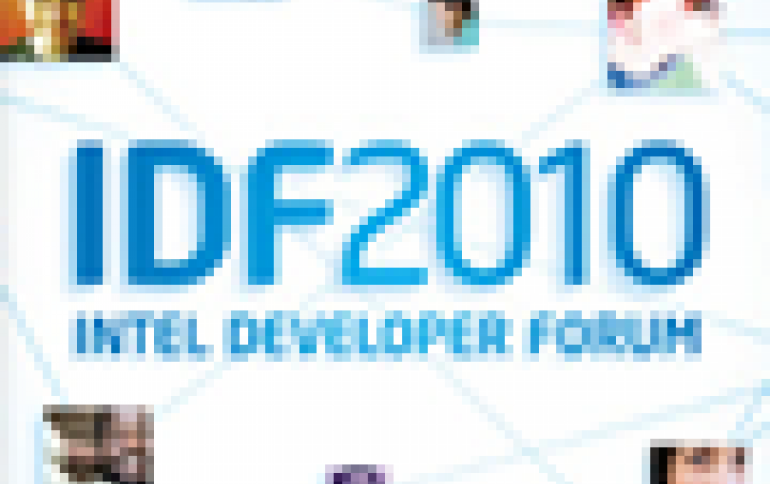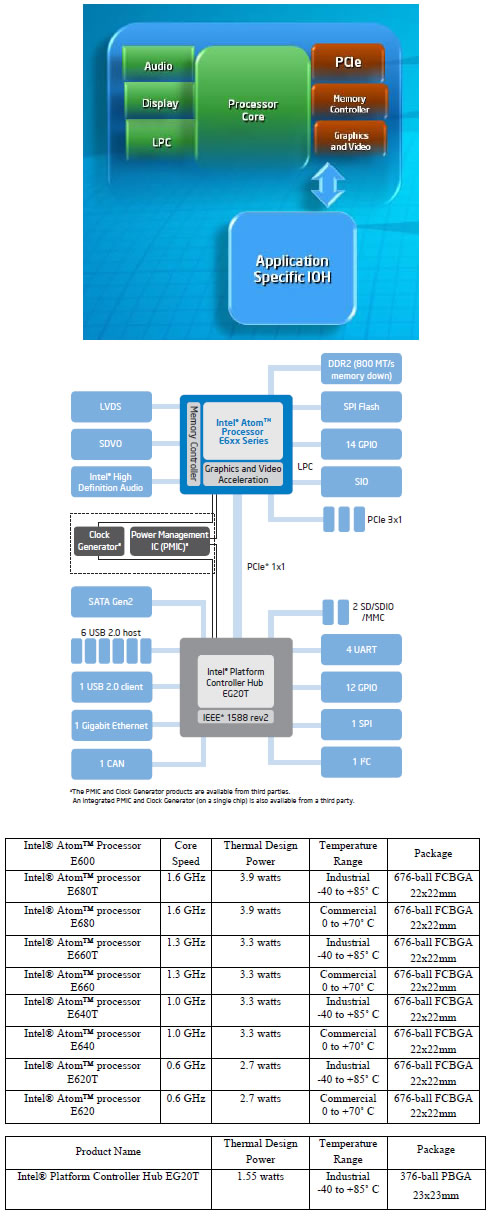
Intel Opens Software App Store, Offers New Intel Atom Chips
During keynote presentations today at the Intel Developer Forum, Intel executives outlined several software- and hardware-related efforts as the company intensifies its System-on-a-Chip (SoC) product plans based on the Intel Atom processor family.
During her keynote at Moscone Center West in San Francisco, Rene James, senior vice president and general manager, Intel Software and Services Group, James outlined how tightly integrated and optimized software and platforms will deliver new levels of performance, along with fresh capabilities and the importance of creating an innovative experience across the personal computing continuum - from PCs to smart phones to tablets and cars, as well as any number of Internet-connected consumer devices.
Emphasizing a seamless experience across operating systems, James introduced general availability of the Intel AppUpSM center netbook app store for consumers. The Intel AppUp center includes both free and paid apps for entertainment, social networking, gaming and productivity, optimized for a netbook's mobility and screen size. To encourage consumers to try new applications, Intel AppUp provides "try before you buy" solutions, encouraging consumers to purchase apps they otherwise might not have. The launch was also marked by the availability of Adobe AIR applications, as well as apps from companies including Accuweather, Barnes & Noble, Funkitron, Gibson Guitars, iWin, Kaplan, KONAMI, and Lifetime.
In an effort to reach netbook owners worldwide, James announced agreements with Best Buy, UK-based Dixons and India-based Croma to outfit each retailer with the Intel AppUp center - pre-installed on netbooks the stores sell, as well as available for current netbook owners to download online. Similarly, James announced plans from ASUS to ship its version of the Intel AppUp center on netbooks, the "asus app store," starting in October.
James also highlighted the Intel AppUp Developer Program, designed to drive applications for end users and new revenue opportunities for independent developers and software vendors with programs such as the Intel Million Dollar Development fund.
James also introduced the "On Intel AppUp" ISV identifier, designed to help developers promote their applications on Intel AppUp center.
James acknowledged seamless experiences are only part of the equation. Open operating systems - such as Intel and Nokia's MeeGo, hosted by the Linux Foundation - allow developers to create and innovate. Pointing to contributions from industry leaders, James discussed MeeGo ecosystem momentum, highlighting a variety of MeeGo-based devices and how third-party software developments and the upcoming MeeGo Web runtime, to be released in October, will make it easier to write applications for these devices. Internet TV pioneer Amino also joined James onstage to demonstrate how the company is taking advantage of the flexibility and openness of MeeGo to deliver an innovative MeeGo-based smart TV solution.
New Atom processors
Discussing the important role the Intel Atom brand plays in delivering intelligent computing to connected devices everywhere, Doug Davis, vice president and general manager, Embedded and Communications Group, outlined the complete Intel Atom processor line and how the company is delivering solutions based on Intel architecture beyond the PC. Davis also emphasized how Intel Atom processor-based solutions can provide the ideal platform for Internet connectivity, intelligence, and ease of design with customer port of choice.
During his keynote, Davis launched "Tunnel Creek," a new Intel Atom E600 SoC processor series developed specifically for embedded applications such as in-vehicle infotainment systems for cars, smart grid devices and IP media phones.
The SoC integrates additional capabilities onto the chip and features an open interconnect for added flexibility. It includes a 45nm Intel Atom processor core (512K L2 cache, 24K data and 32K instruction L1 cache), 3D graphics and video encode plus memory and display controllers in one package. In also includes Intel Graphics Media Accelerator (GMA) 600 graphics engine (400MHz core, OpenGLES2.0, OpenGL2.1, OpenVG 1.1 and hardware-accelerated HD video decode and encode). An integrated 32-bit single-channel memory controller offres fast performance. Processors include support for DDR2 800MT/s memory technology up to 2GB.
Making it easier to design and customize with these new products, Vendors including OKI Semiconductor, Realtek Semiconductor and STMicroelectronics will offer interconnect chipsets, and other companion silicon offerings from Dialog Semiconductor and ROHM Co. will regulate voltages and synchronize clocks, according to Davis.
The processor series will be available to Intel's customers later this year.

Davis went on to unveil details of an upcoming new configurable Atom processor, codenamed "Stellarton." The processor consists of the Atom E600 processor paired with an Altera FPGA on a multi-chip package; which provides additional flexibility for customers who want to incorporate proprietary I/O or acceleration and enabling developers to differentiate their designs by reacting quickly to changing requirements
Davis also introduced the Intel Atom processor CE4200, formerly codenamed "Groveland," which is designed to help integrate the Internet experience with TV.
The SoC includes 3-D support, H.264 high-definition encoding capability for usage models such as "sync-and-go" between networked consumer electronics and portable devices, and multiple input stream support to enable the design of cost-effective home gateway appliances.
The SoC pairs an 1.2 GHz Intel Atom processor core and 512K L2 cache.
To help address regulatory requirements, the SoC features smart power management capabilities that automatically help to turn off parts of the chip when not in use. A software development kit and familiar tools for integrating applications is also available which OEMs can re-use across products, cutting development time. Davis announced ADB, Samsung, Sagemcom and Technicolor plan to build set-top boxes based on the new SoC.
Microsoft, Dell and Visteon joined Davis on stage during his keynote. Microsoft announced they have ported Windows Embedded Standard 7 and Windows Media Center on Intel architecture and demonstrated prototype devices from Acer and ASUS. Dell previewed their upcoming Intel Atom processor-based Dell convertible mobile device, expected to be available later this year. Visteon demonstrated the use of the E600 series processor in a next-generation automotive infotainment platform.
Davis also highlighted mobility products based on the upcoming Intel SoC, codenamed "Oak Trail." Touting Intel?s port of choice message, mobile device demonstrations included an ExoPC running Microsoft Windows Embedded Standard 7, a WeTab running MeeGo and a Cisco Cius running Android.
New Classmate PC
At IDF, Intel also announced the latest clamshell classmate PC design. It features increased ruggedness, longer battery life, improved water resistance and aditional anti-microbial protection.
Emphasizing a seamless experience across operating systems, James introduced general availability of the Intel AppUpSM center netbook app store for consumers. The Intel AppUp center includes both free and paid apps for entertainment, social networking, gaming and productivity, optimized for a netbook's mobility and screen size. To encourage consumers to try new applications, Intel AppUp provides "try before you buy" solutions, encouraging consumers to purchase apps they otherwise might not have. The launch was also marked by the availability of Adobe AIR applications, as well as apps from companies including Accuweather, Barnes & Noble, Funkitron, Gibson Guitars, iWin, Kaplan, KONAMI, and Lifetime.
In an effort to reach netbook owners worldwide, James announced agreements with Best Buy, UK-based Dixons and India-based Croma to outfit each retailer with the Intel AppUp center - pre-installed on netbooks the stores sell, as well as available for current netbook owners to download online. Similarly, James announced plans from ASUS to ship its version of the Intel AppUp center on netbooks, the "asus app store," starting in October.
James also highlighted the Intel AppUp Developer Program, designed to drive applications for end users and new revenue opportunities for independent developers and software vendors with programs such as the Intel Million Dollar Development fund.
James also introduced the "On Intel AppUp" ISV identifier, designed to help developers promote their applications on Intel AppUp center.
James acknowledged seamless experiences are only part of the equation. Open operating systems - such as Intel and Nokia's MeeGo, hosted by the Linux Foundation - allow developers to create and innovate. Pointing to contributions from industry leaders, James discussed MeeGo ecosystem momentum, highlighting a variety of MeeGo-based devices and how third-party software developments and the upcoming MeeGo Web runtime, to be released in October, will make it easier to write applications for these devices. Internet TV pioneer Amino also joined James onstage to demonstrate how the company is taking advantage of the flexibility and openness of MeeGo to deliver an innovative MeeGo-based smart TV solution.
New Atom processors
Discussing the important role the Intel Atom brand plays in delivering intelligent computing to connected devices everywhere, Doug Davis, vice president and general manager, Embedded and Communications Group, outlined the complete Intel Atom processor line and how the company is delivering solutions based on Intel architecture beyond the PC. Davis also emphasized how Intel Atom processor-based solutions can provide the ideal platform for Internet connectivity, intelligence, and ease of design with customer port of choice.
During his keynote, Davis launched "Tunnel Creek," a new Intel Atom E600 SoC processor series developed specifically for embedded applications such as in-vehicle infotainment systems for cars, smart grid devices and IP media phones.
The SoC integrates additional capabilities onto the chip and features an open interconnect for added flexibility. It includes a 45nm Intel Atom processor core (512K L2 cache, 24K data and 32K instruction L1 cache), 3D graphics and video encode plus memory and display controllers in one package. In also includes Intel Graphics Media Accelerator (GMA) 600 graphics engine (400MHz core, OpenGLES2.0, OpenGL2.1, OpenVG 1.1 and hardware-accelerated HD video decode and encode). An integrated 32-bit single-channel memory controller offres fast performance. Processors include support for DDR2 800MT/s memory technology up to 2GB.
Making it easier to design and customize with these new products, Vendors including OKI Semiconductor, Realtek Semiconductor and STMicroelectronics will offer interconnect chipsets, and other companion silicon offerings from Dialog Semiconductor and ROHM Co. will regulate voltages and synchronize clocks, according to Davis.
The processor series will be available to Intel's customers later this year.

Davis went on to unveil details of an upcoming new configurable Atom processor, codenamed "Stellarton." The processor consists of the Atom E600 processor paired with an Altera FPGA on a multi-chip package; which provides additional flexibility for customers who want to incorporate proprietary I/O or acceleration and enabling developers to differentiate their designs by reacting quickly to changing requirements
Davis also introduced the Intel Atom processor CE4200, formerly codenamed "Groveland," which is designed to help integrate the Internet experience with TV.
The SoC includes 3-D support, H.264 high-definition encoding capability for usage models such as "sync-and-go" between networked consumer electronics and portable devices, and multiple input stream support to enable the design of cost-effective home gateway appliances.
The SoC pairs an 1.2 GHz Intel Atom processor core and 512K L2 cache.
To help address regulatory requirements, the SoC features smart power management capabilities that automatically help to turn off parts of the chip when not in use. A software development kit and familiar tools for integrating applications is also available which OEMs can re-use across products, cutting development time. Davis announced ADB, Samsung, Sagemcom and Technicolor plan to build set-top boxes based on the new SoC.
Microsoft, Dell and Visteon joined Davis on stage during his keynote. Microsoft announced they have ported Windows Embedded Standard 7 and Windows Media Center on Intel architecture and demonstrated prototype devices from Acer and ASUS. Dell previewed their upcoming Intel Atom processor-based Dell convertible mobile device, expected to be available later this year. Visteon demonstrated the use of the E600 series processor in a next-generation automotive infotainment platform.
Davis also highlighted mobility products based on the upcoming Intel SoC, codenamed "Oak Trail." Touting Intel?s port of choice message, mobile device demonstrations included an ExoPC running Microsoft Windows Embedded Standard 7, a WeTab running MeeGo and a Cisco Cius running Android.
New Classmate PC
At IDF, Intel also announced the latest clamshell classmate PC design. It features increased ruggedness, longer battery life, improved water resistance and aditional anti-microbial protection.





















